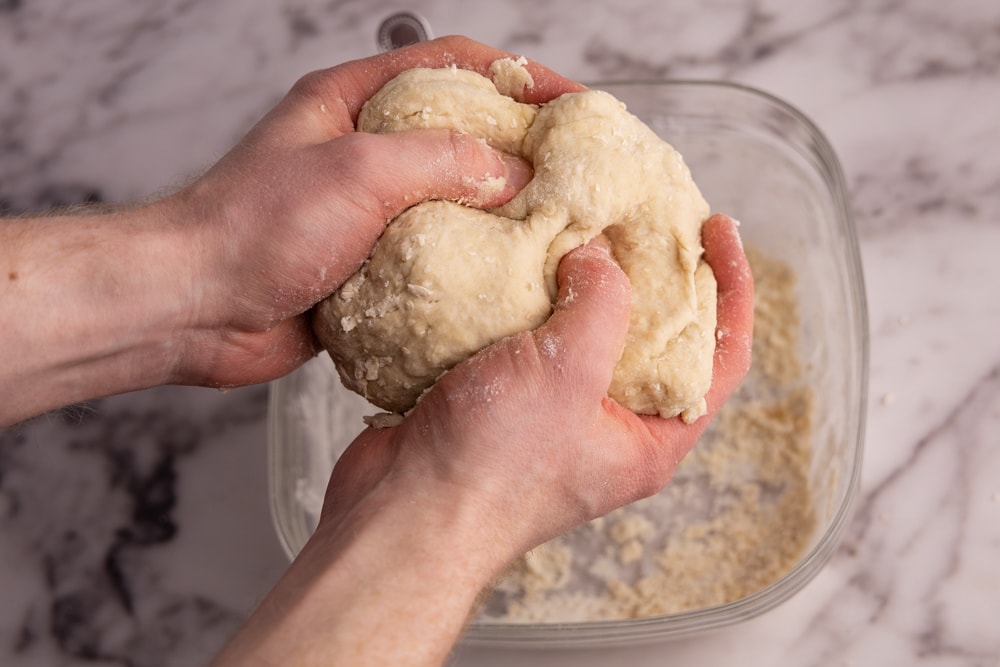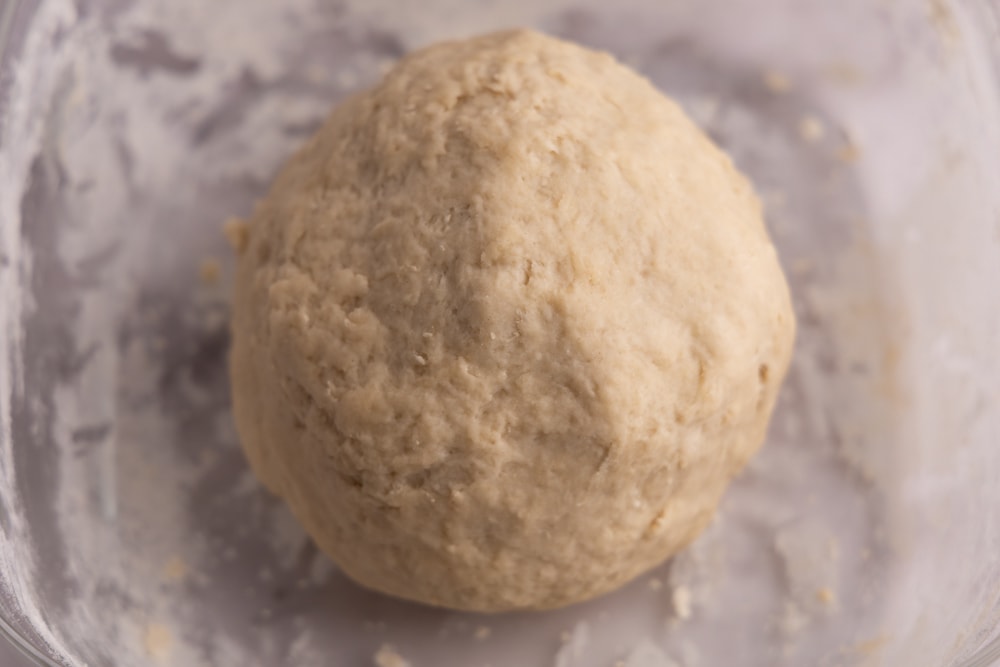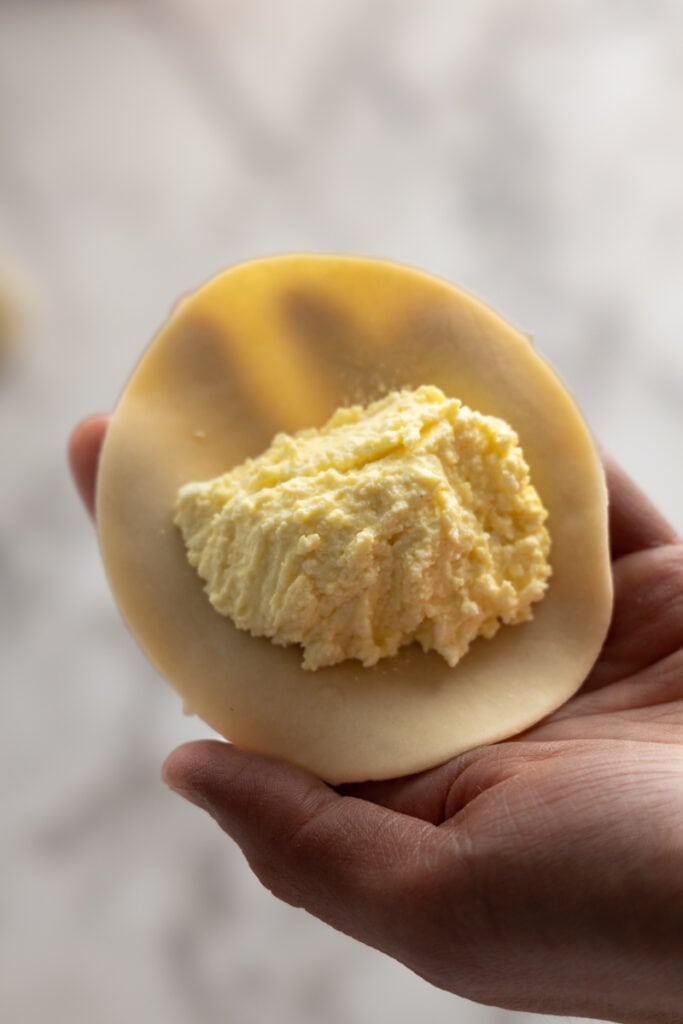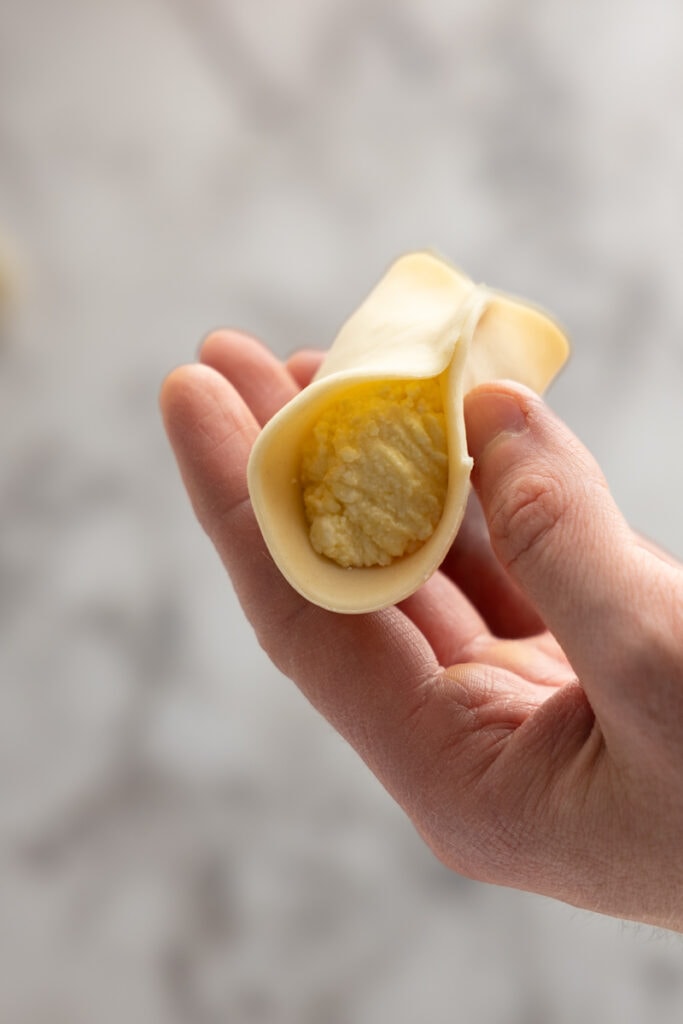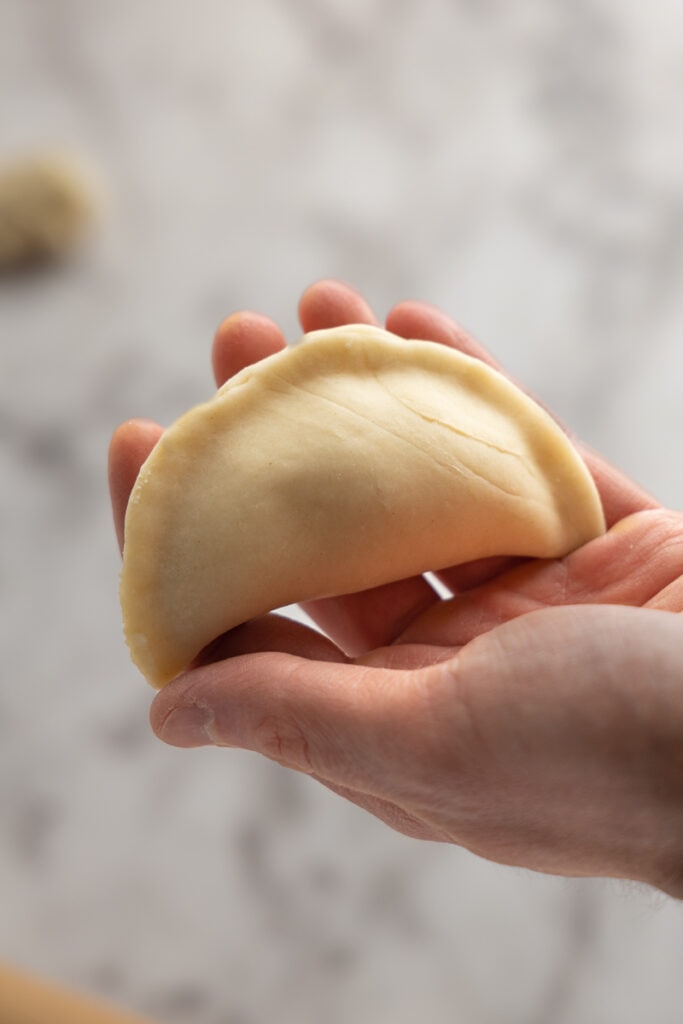Farmer’s Cheese Pierogi Recipe
This post may contain affiliate links. Read our privacy policy.
Get ready to indulge in a classic Polish dish with these delicious Farmer’s Cheese Pierogi. The dough is light and tender, while the filling is creamy and slightly sweet. It’s a recipe that will transport you to the heart of Poland.

Here’s a new favorite for you: the farmer’s cheese pierogi, a Polish classic right alongside meat pierogi and the delicious potato-and-cheese variety. This recipe is a crowd-pleaser with its budget-friendly, easy-to-make filling that’s seriously tasty. If you spot farmer’s cheese in your local store, grab some and let’s get cooking.
(If you can’t easily buy farmer’s cheese, use cream cheese instead and follow my sweet cheese pierogi recipe.)
Naming
In Poland, this cheese is called “twaróg.” If you do a quick Wikipedia search, you’ll find it listed as quark, but in recipes, it’s usually referred to as farmer’s cheese. It’s a fresh cheese, somewhat like cottage cheese but without the liquid, so it’s dry and chewy. Just make sure to avoid the cured variety that’s more like cheddar or low-moisture mozzarella.
Recipe At a Glance
Let’s dive into why this farmer’s cheese pierogi recipe is a must-try:
- Simplicity at its finest. Looking for a sweet pierogi filling that comes together in a snap? This recipe is your perfect match. All it takes is combining a few ingredients and voila, you’re ready to shape those pierogi. Plus, the filling holds up really well, making the dough-wrapping process super beginner-friendly.
- Universal appeal. With the classic sweet-and-sour blend of sugar and farmer’s cheese, the filling has a delightfully neutral flavor. This means it’s a hit with just about anyone who’s a fan of dessert pierogi.
- Perfect for freezing. Feel free to double or even triple the batch, and stash some away for later – a real time-saver.
First-timers, make sure to check out the ingredient notes, step-by-step instructions, and handy tips before you start. If you’re a pierogi pro, you can skip straight to the recipe card.
Extra Learning
Before we jump in, here are a few handy resources to help you nail this recipe:
- Homemade Pierogi for Beginners. My pierogi guide that walks you through the pierogi making process, start to finish. Whether you’re new to pierogi or just need a refresher, this guide has you covered.
Ingredients Notes and Substitutes
Pierogi Dough
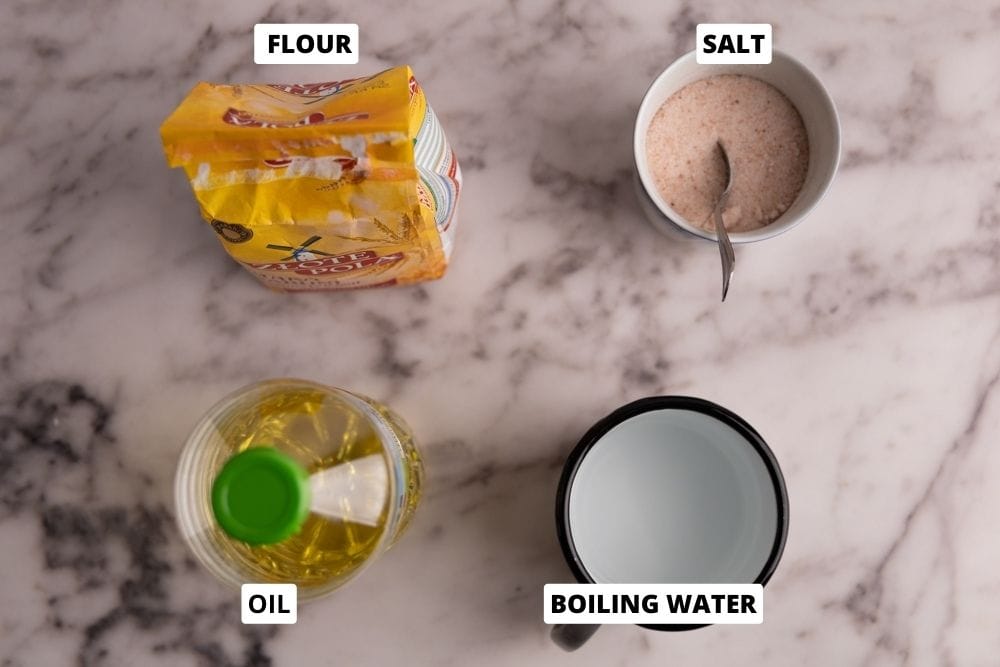
- Flour. Use all-purpose flour. If you use something like bread flour or whole wheat flour, you will need noticeably more liquid to achieve the right dough texture.
- Oil. Use a neutral-flavored oil, such as your regular cooking oil. Avoid olive oil as it can be bitter, which may affect the dough’s flavor.
- Salt. Use fine-grained salt for best results.
- Water. Plain boiled water is all you need; no need to be fancy here.
Farmer’s Cheese Pierogi Filling

- Farmer’s Cheese. So far, I haven’t found a decent substitute for this particular recipe. When buying, check that it’s the correct type of farmer’s cheese – it should resemble fresh cottage cheese but be drier and chewier, as it lacks any dressing.
- Egg Yolks.
- Sugar. I use white sugar, but whether it’s white sugar, brown sugar, coconut sugar, or your preferred sugar substitute, any can work in this recipe. The flavor will slightly differ depending on what you go with, though.
- Vanilla Extract. It’s an optional touch but definitely enhances the flavor profile. Though, rest assured, your pierogi will still be delicious without it.
Step-By-Step: How to Make Farmer’s Cheese Pierogi
Step 1: Make Dough
(Read more about this in our pierogi dough recipe.)
- Boil a pot of water.
- Sift flour into a large bowl. Sifting probably isn’t necessary, but I recommend it anyways. Plus, it’s something you can do while waiting for the water to boil.
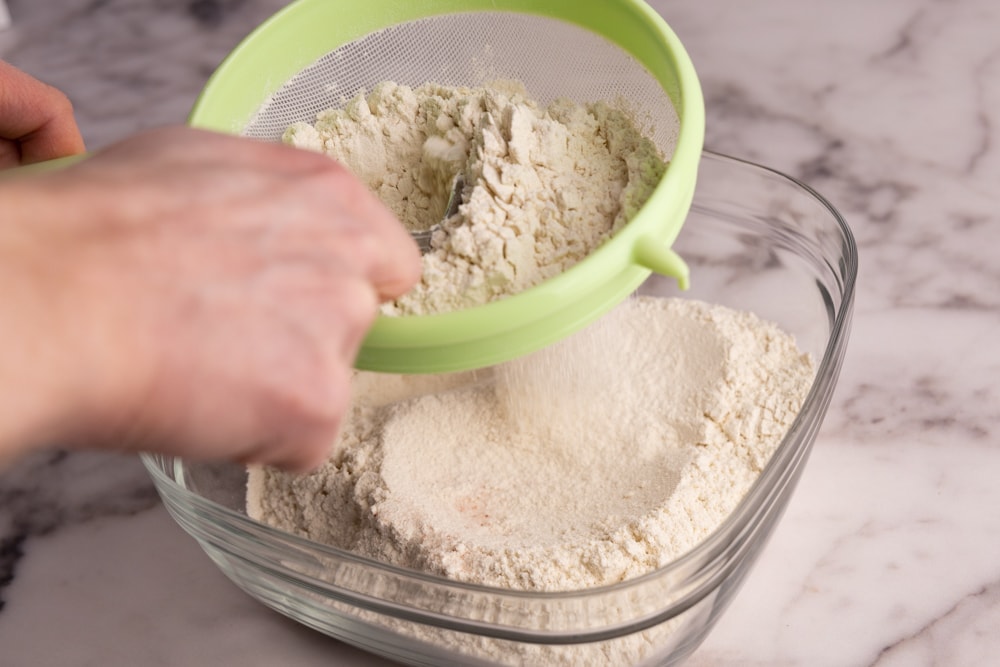
- Add salt and mix. Just a quick stir to spread the salt.
- Add oil and boiled water.
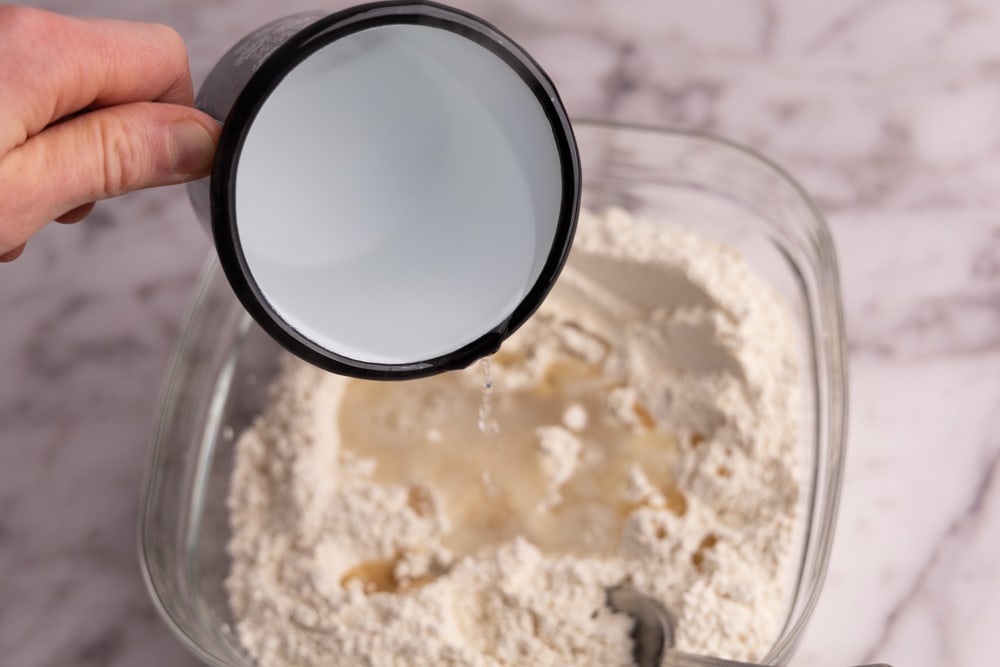
- Mix. Mix the ingredients by stirring with a regular tablespoon or a large wooden spoon. Be careful not to burn yourself, as you will be working with water that was boiling just a few moments ago. Stir until you reach the point where there is no visible water in the bowl, then switch to using your hands.
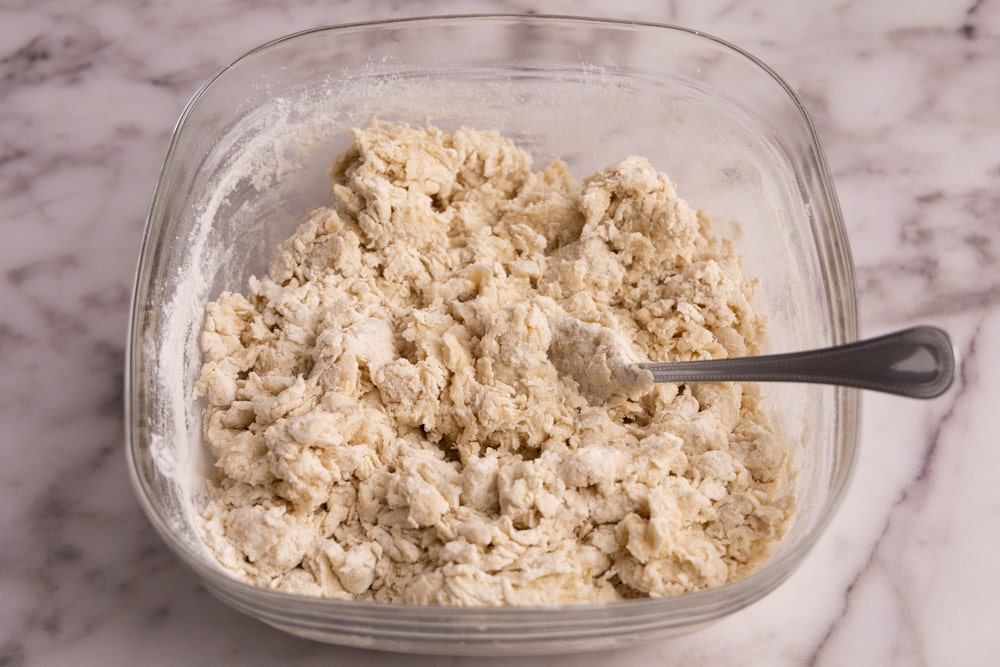
- Knead. Start slowly and make sure the dough isn’t too hot to handle. Knead until you have incorporated all the flour into a homogeneous dough ball, which usually takes 4 to 8 minutes.
 Kneading in progress. Note that there’s still flour left in the bowl.
Kneading in progress. Note that there’s still flour left in the bowl. Dough ready – all the flour is incorporated and the dough is pretty homogenous.
Dough ready – all the flour is incorporated and the dough is pretty homogenous.
- Wrap and rest. Wrap the dough ball tightly in plastic wrap and let it rest for about 30 minutes before continuing. This will allow the dough to relax and become easier to work with.
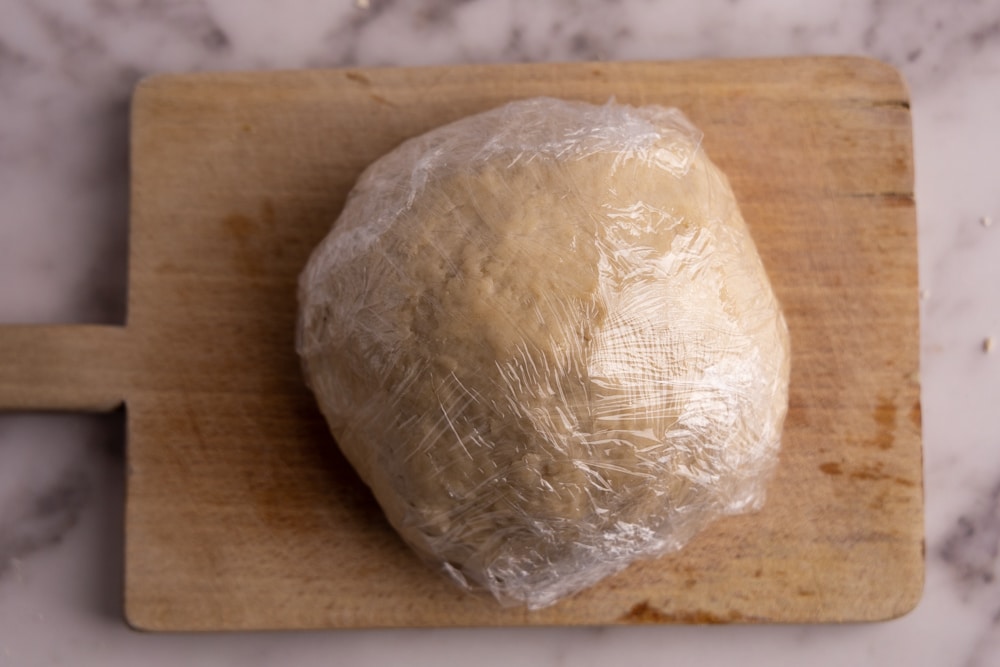
- Make pierogi. Once that half an hour of waiting is over, the dough is ready for rolling and making pierogi.
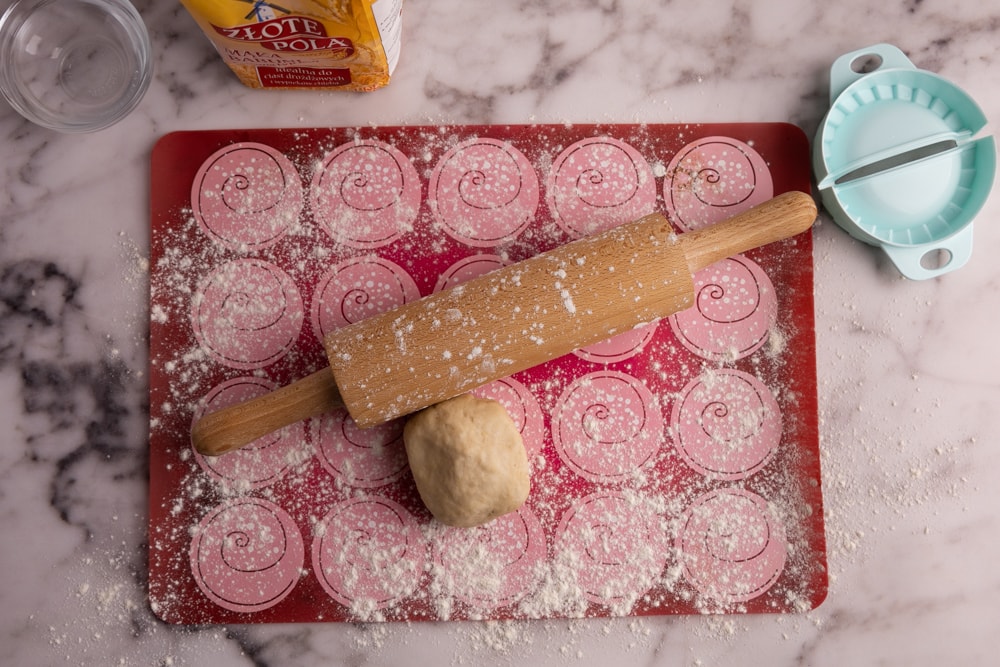
Step 2: Prep Filling
- Filling mix: In a bowl, blend the farmer’s cheese, sugar, and vanilla extract. Give it a thorough stir and taste. If it needs a bit more tang, add a splash of lemon juice.
- Add egg yolks: Once you’re happy with the flavor, stir in the two egg yolks. Use the filling right away, or if you plan to use it later, pop it in the fridge.
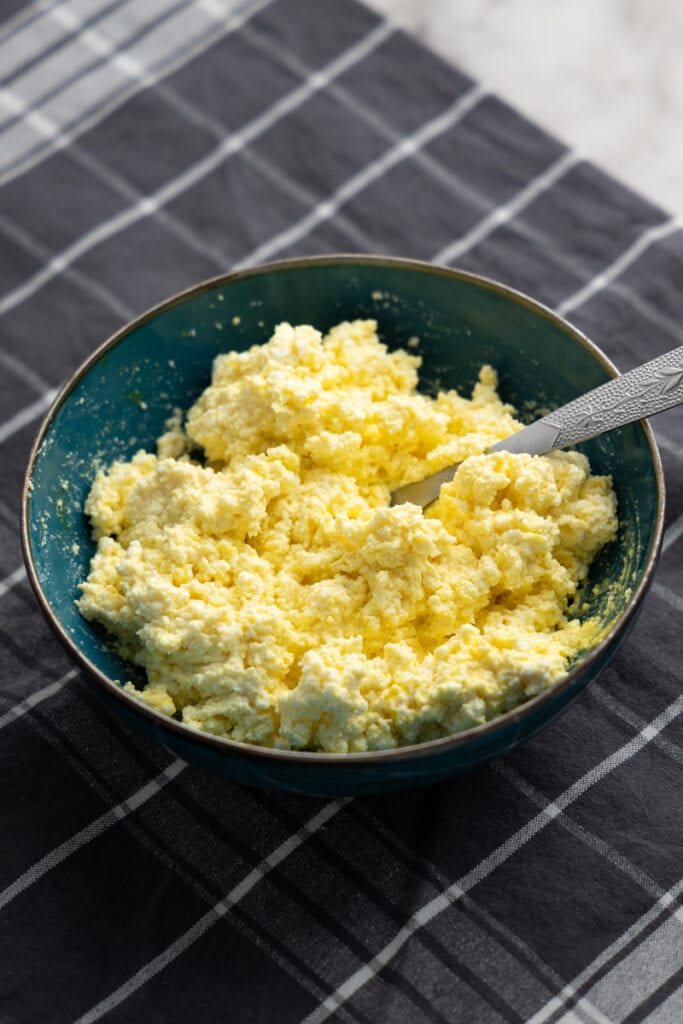
Step 3: Combine
- Divide. Divide the pierogi dough into two or three parts. Take one part and spread it on a floured work surface, then roll it out until it’s nice and thin. Be careful not to roll it too thin, as it may tear when you form the pockets and seal the dough around the filling. Wrap the rest of the dough tightly to prevent it from drying out.
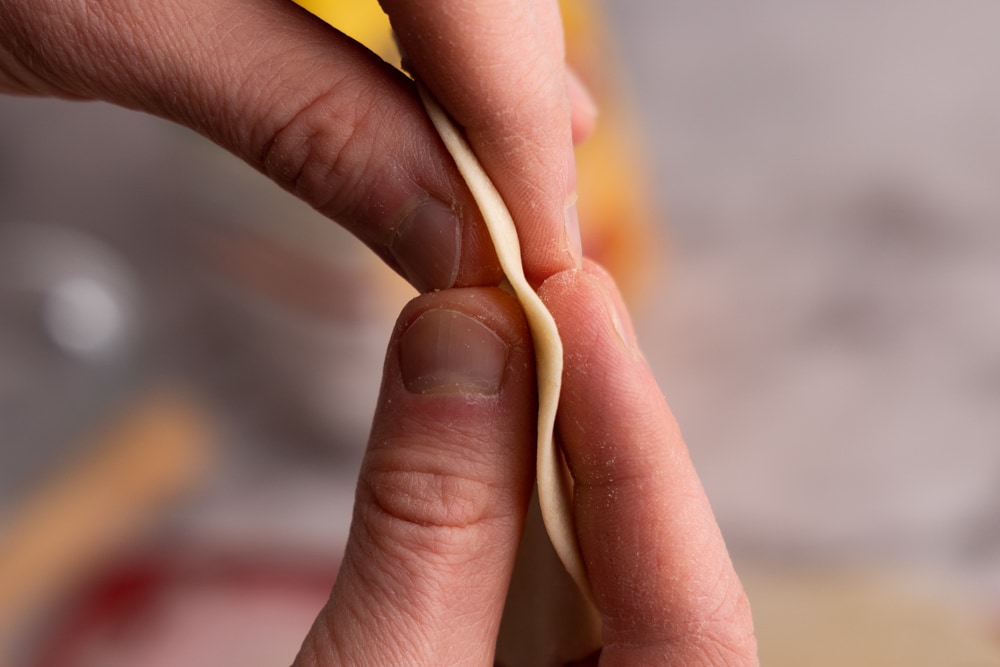
- Cut into circles. Cut palm-sized circles in the rolled pierogi dough. Anything round with a somewhat sharp edge is great, but a simple glass or mason jar works as well. Or use your pierogi maker if you have one. Form a ball with the dough left over after cutting and use it when rolling out the rest of the pierogi.
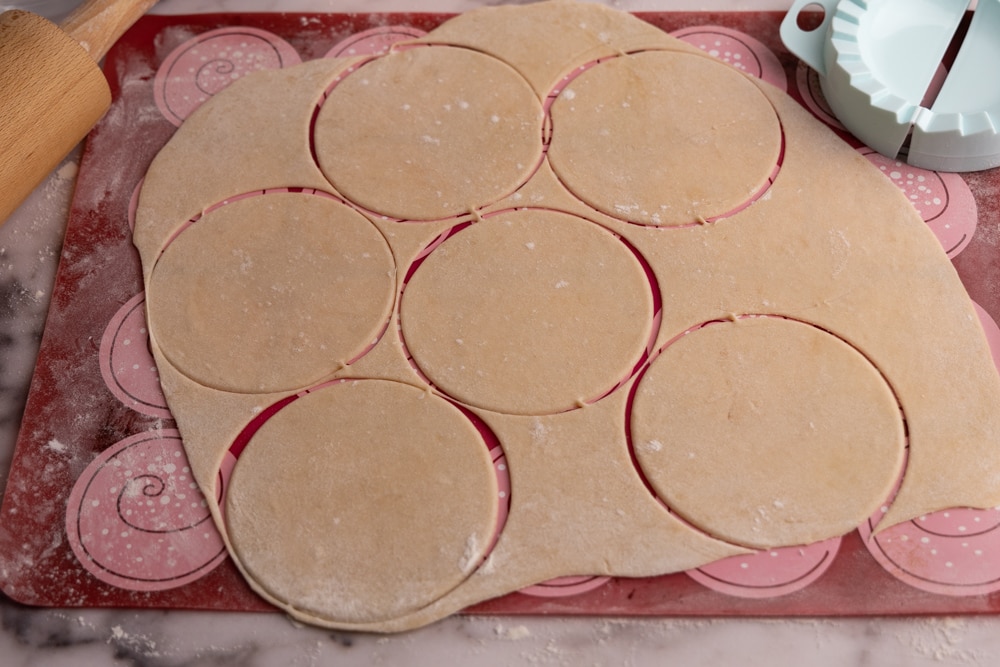
- Shape the pierogi: Place a spoonful of the farmer’s cheese filling onto a dough circle, fold the dough over, and press the edges together, starting from the center. Ensure to squeeze out any trapped air. If the dough resists sealing, lightly moisten the edges with a damp finger.
 Add filling
Add filling Fold and press together the middle
Fold and press together the middle Finish
Finish
- Cover with damp towel. Place each formed pierogi on a floured cookie sheet and cover them with a damp kitchen towel. The edges will dry out quickly otherwise. If you want to save space and let the pierogi touch each other, lightly brush the areas where they’ll touch with flour. This will prevent them from sticking together and causing the pierogi dough to tear when removed for boiling.
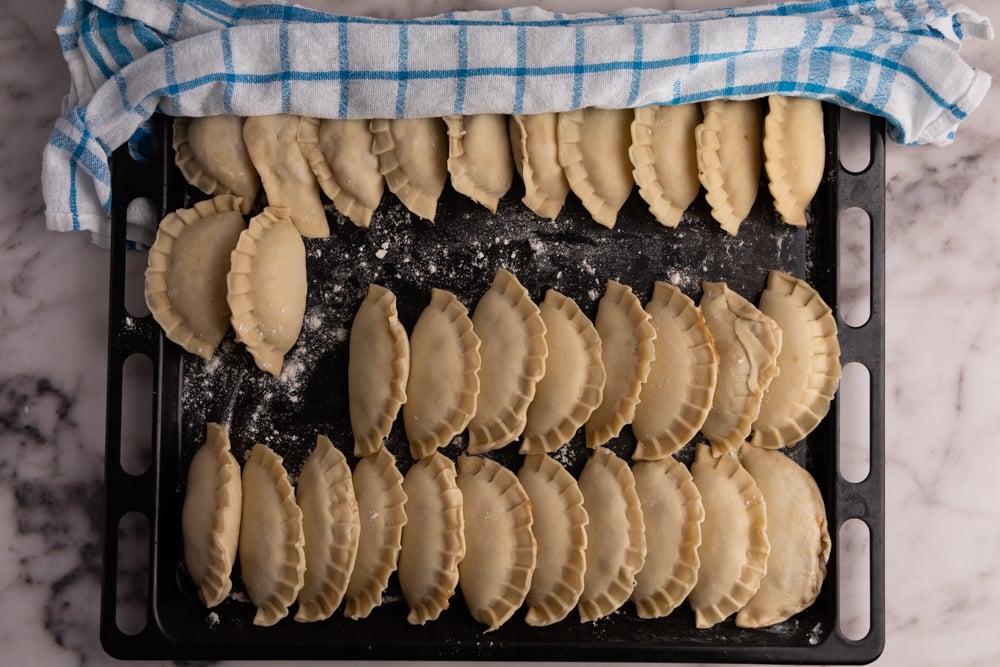
- Make more pierogies. Continue forming pierogi until you run out of dough or filling.
Step 4: Cook
- Boil water. Bring a large pot of salted water to a boil. I typically use one teaspoon of salt per quart of water but feel free to adjust the amount to your preferences.
- Add a few pierogi. Once the water is boiling, add a few pierogi to the pot and stir them to prevent them from sticking to the bottom. Once the pierogi start floating to the surface, simmer them gently for another 3 to 4 minutes. Make sure not to overcrowd the pot so that the pierogi don’t stick together or cook unevenly.
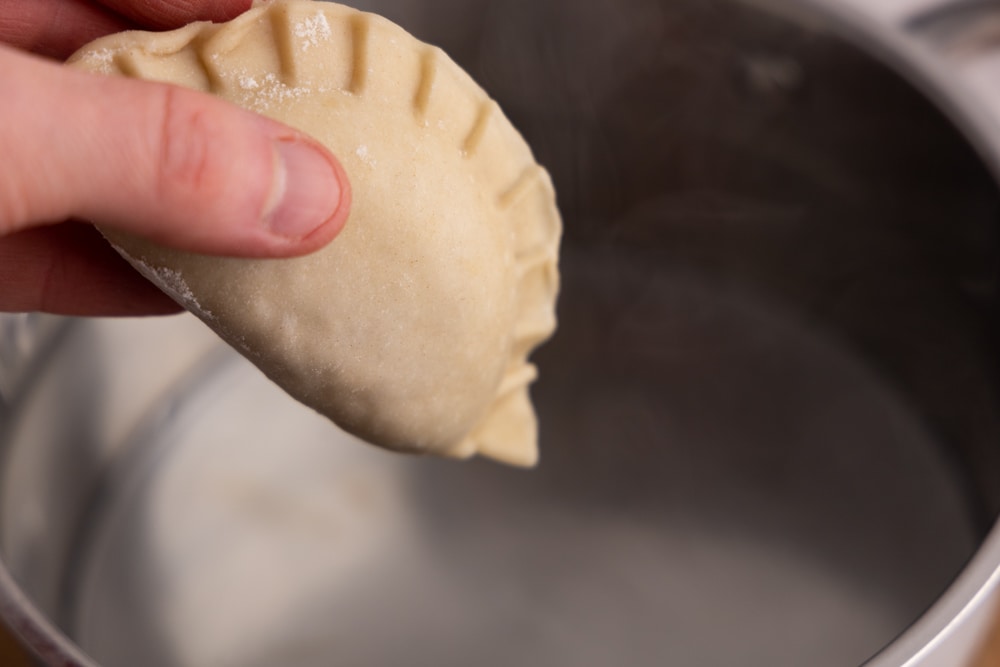
- Remove. Remove the pierogi from the water using a slotted spoon.
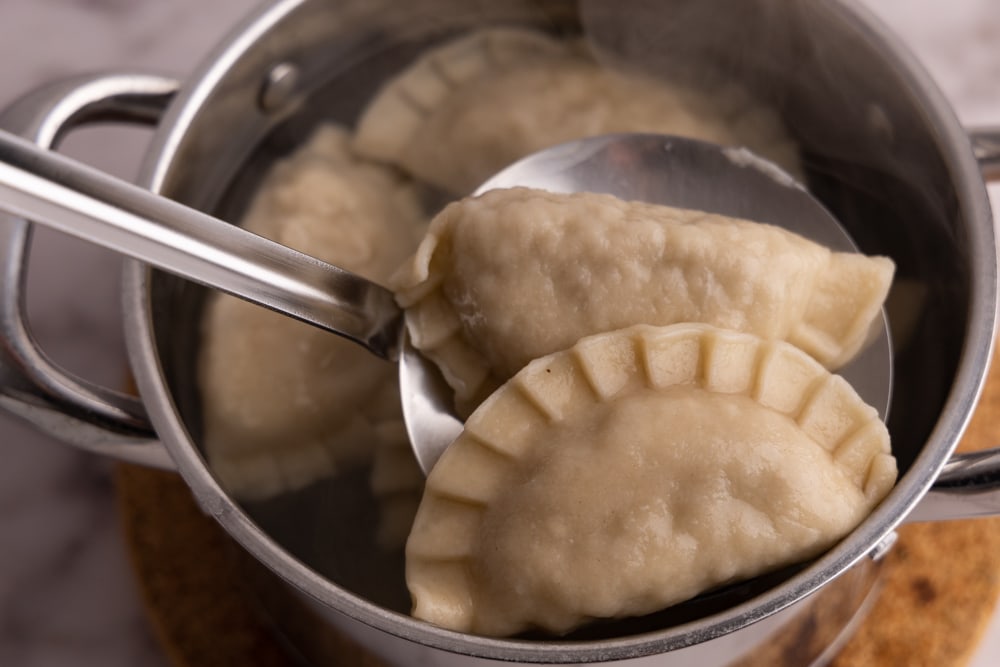
- Serve: Now, your deliciously cooked pierogi are ready to be served and savored.

Recipe Tips
Here are some tips for making farmer’s cheese pierogi:
- Keep a small bowl of water nearby: As a beginner pierogi maker, it’s common for the dough edges not to stick together properly because of excess flour. To quickly seal the pierogi, have a small bowl of water nearby. If you find that the dough isn’t sticking together, simply moisten your finger with water and use it to seal the edges of the pierogi.
- Start boiling water halfway through: To save time, start boiling the water when you’re about halfway through making the dough or filling. This way, once the water reaches a boil, you can immediately add a couple of pierogi to the pot. While these pierogi cook, you can continue forming the remaining ones with the remaining ingredients. This tip typically saves you 10 to 15 minutes.
Serving Suggestions
To serve Farmer’s Cheese Pierogi, you have several delicious options:
- Enjoy them as is: These pierogi are already filled with a sweet and tasty farmer’s cheese filling, so you can simply serve them as they are. They are delicious on their own and don’t need any additional toppings to taste great.
- Pan-fry them: For a crispy and flavorful twist, you can pan-fry the pierogi. Heat a non-stick pan and add a knob of butter. Once the butter melts, add the pierogi and cook them for a couple of minutes on each side until they turn golden brown and crispy. This cooking method enhances the texture and makes the flavor even more enjoyable.
- Top with melted butter: If you decide to pan-fry the pierogi, you can use the butter from the pan to drizzle over the top. This adds a rich and buttery taste that complements the sweetness of the filling. For an extra touch, you can sprinkle them with powdered sugar.
- Sour cream and powdered sugar: Another classic option is to serve the pierogi with a dollop of sour cream on top. This adds a tangy element that balances out the sweetness. If you find it too tangy, you can dust them with powdered sugar to mellow the flavors.
- Simple berry sauce: For a fruity twist, you can make a quick and easy berry sauce. Blend half a cup of berries (strawberries, blueberries, or your favorite) using an immersion blender. Add a couple of tablespoons of thick yogurt (such as Greek yogurt or skyr) or sour cream. Stir in half a teaspoon of sugar, taste the sauce, and adjust the sweetness if needed. This sauce adds a vibrant and refreshing element to the dish. You can also add some fresh berries on top for an extra burst of flavor. Or if you want to make the food look Instagram-worthy.
These serving options will elevate your Farmer’s Cheese Pierogi and make them even more enjoyable. Choose the one that appeals to you the most or try a combination for a variety of flavors.
(And make sure to read our guide to pierogi toppings for more ideas.)

Storage
Firstly, dry the freshly cooked pierogi by placing them on large plates in such a way that they aren’t touching each other. Let them air-dry for about 15 to 20 minutes, then flip them over for another 15 to 20 minutes on the other side. The aim here is to make sure both sides are nice and dry to prevent any stickiness during storage.
Once they’re dry, transfer the pierogi into an airtight container. If there’s any contact between pierogi, try to minimize it as this will help prevent them from sticking together.
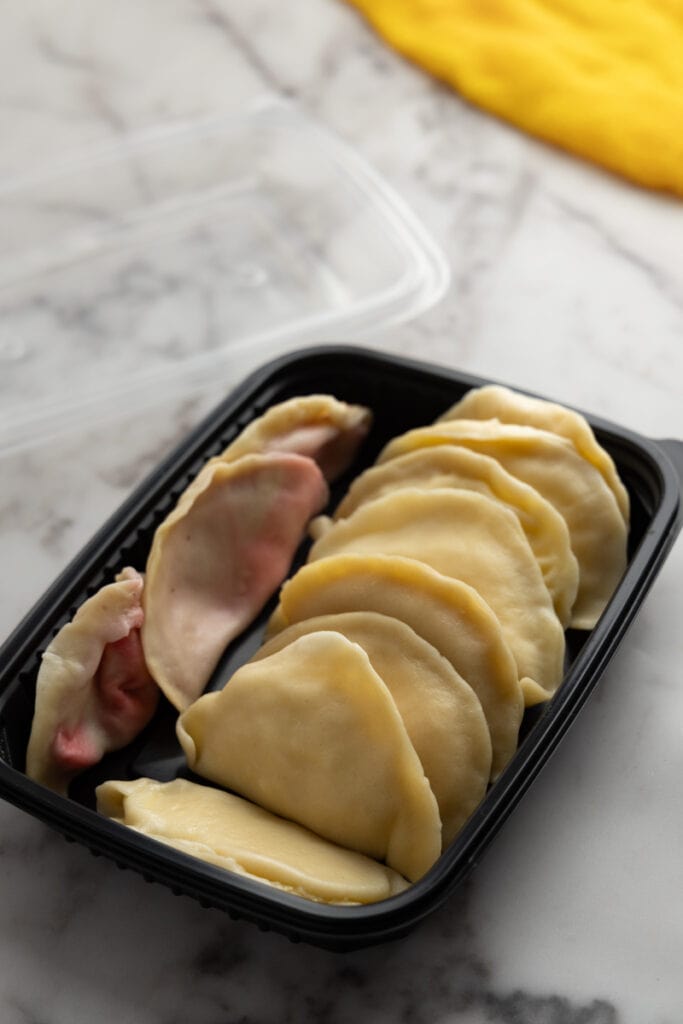
Should you need to stack the pierogi within the container, ensure to create a barrier between each layer. You can use either plastic wrap or aluminum foil for this, which will stop the layers from sticking to one another.
Once your pierogi are all nestled in their container or containers, seal them up and pop them in the refrigerator. Here, they can chill out and stay fresh for three to four days, ready for when you want to enjoy them next.
If you have a bigger batch of pierogi and are looking to store them for longer, freezing is a great option.
How to Reheat
Want to reheat those? The most effective and straightforward method is pan-frying. Follow this easy guide:
- Place a nonstick skillet over medium heat on your stovetop.
- Melt a knob of butter in the skillet, ensuring it covers the base of the pan.
- Gently lay the pierogi into the warm skillet, being careful not to overcrowd them.
- Let the pierogi sizzle for about four to six minutes on one side until they’re well heated and sporting a lovely golden brown hue.
- Using a spatula, turn the pierogi over with a gentle hand.
- Allow the other side to cook for another four to six minutes, until it’s equally golden brown and warmed through.
- Dish up and serve.
Pan-frying will give your pierogi that crispy outer layer while making sure the inside is warmed to perfection. The added butter lends a delightful richness and boosts the overall taste.
Once your farmer’s cheese pierogi are all warmed up, serve them hot and relish their delectable flavor and texture. Be it as a side, a main dish, or a quick snack, these pan-fried pierogi will definitely hit the spot.

Equipment
Ingredients
Pierogi Dough
- 2 cups all-purpose flour ~250g
- ¼ tsp salt
- 1 ½ tbsp oil
- ½ cup boiling water ~120ml
Farmer's Cheese Pierogi Filling
- 18 oz farmer’s cheese ~510 g
- 2 egg yolks
- 2 oz sugar ~56 g
- 2 teaspoons vanilla extract
Instructions
Make Dough
- Boil Water: Boil a pot of water.½ cup boiling water
- Sift Flour: Sift flour into a large bowl.2 cups all-purpose flour
- Add Salt: Add salt and mix.¼ tsp salt
- Wet Ingredients: Add oil and boiled water.1 ½ tbsp oil
- Mix Ingredients: Mix the ingredients by stirring with a spoon. Be careful not to burn yourself. Once there is no visible water in the bowl, use your hands to knead the dough until it is a homogeneous ball.
- Wrap and Rest: Wrap the dough ball tightly in plastic wrap and let it rest for about 30 minutes before continuing.
- Make Pierogi: Once the wait is over, the dough is ready for rolling and making pierogi.
Prep Filling
- Make Filling: Mix farmer's cheese, sugar, and vanilla extract. Taste and add more sugar or some lemon juice if needed.18 oz farmer’s cheese, 2 oz sugar, 2 teaspoons vanilla extract
- Add Egg Yolks: Incorporate the egg yolks, then refrigerate if not using immediately.2 egg yolks
Combine
- Cut Dough: Divide the rested dough into 2-3 portions, roll out the first on a floured surface to a thin but sturdy thickness.
- Form Circles: Use a round cutter or glass to cut dough circles, repurposing any remnants for extra pierogi.
- Make Pierogi: Place filling on a dough circle, fold and seal from the center, expelling trapped air. Moist edges with a wet finger if needed.
- Cover: Move pierogi to a flour-dusted surface, covered by a damp towel. Dust flour on touching areas to prevent sticking.
Cook
- Boil: Cook pierogi in boiling, salted water until they float, then simmer for 2-3 additional minutes.
- Scoop: Use a slotted spoon to extract the cooked pierogi from the pot.
- Serve: Serve the finished pierogi hot.
Hungry for More?
If you’re into pierogi, you definitely should check out my other recipes for dessert pierogi:
- Apple pierogi. Who doesn’t like pierogi with a delicious sweet and sour apple filling?
- Strawberry pierogi. There work with both fresh and frozen strawberries, making it an option you can enjoy the whole year round.
- Blueberry pierogi. Another sweet pierogi variety that works with fresh and frozen berries, and they taste equally well.
- Pierogi fillings. Here’s our epic guide to pierogi fillings. Learn everything you need about filling pierogi and stuffing options.

